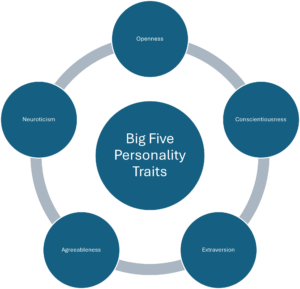What is personality in general
Personality refers to a unique set of characteristic thoughts, emotions, and behaviors that differentiate one person from another. It encompasses a wide array of traits and patterns that influence how we respond to various situations, how we interact with others, and how we make our decisions. These traits are deeply ingrained within us and shape who we are as individuals.
A fundamental aspect of personality is its consistency over time and across different situations. While people can undergo certain adjustments and changes in their behavior and beliefs through experiences and over time, the core traits of their personality remain relatively stable. This consistency allows us to make predictions about behavior and develop a deep understanding of the unique way each person experiences and reacts to the world.
The notion that personality possesses a stable structure is reflected in numerous psychological theories and models that attempt to categorize and explain the various facets of personality. This stability of personality is crucial for the development of relationships, navigating social life, and individual adaptation to the environment. It is both the product of an individual’s genetic makeup and the result of their life experiences, which work together to form the unique personality of each person.
The Big Five Personality Traits Model
The Big Five personality factors, also known as the Five-Factor Model (FFM), represent a comprehensive framework for describing and analyzing human personality. This model is predicated on the premise that five primary dimensions are sufficient to broadly capture human personality. These dimensions are:

- Openness to Experience (Openness): This dimension pertains to the extent to which a person is creative, curious, and open to new experiences. Individuals scoring high on openness tend to appreciate innovative and creative activities and have a wide range of interests.
- Conscientiousness: Conscientiousness measures reliability, organization, and the ability to follow through with plans and tasks methodically. High scores in this dimension indicate a person who is disciplined, well-organized, and goal-oriented.
- Extraversion: This dimension assesses the extent to which someone is sociable, energetic, and positive in social interactions. Extraverted individuals draw energy from interacting with others and are generally optimistic and talkative.
- Agreeableness: Agreeableness measures the degree of friendliness, compassion, and cooperativeness. Individuals with high scores in this dimension are usually understanding, kind, and maintain positive relationships with others.
- Neuroticism: This dimension evaluates emotional stability and the extent to which individuals are prone to negative emotions such as anxiety, anger, or depression. A high score in neuroticism indicates a greater tendency towards emotional instability and negative feelings.
Why are the Big Five suitable for explaining personality?
The Big Five personality factors offer a robust, empirically supported framework for capturing human personality differences. This model stands out for its simplicity and complexity, mapping a broad spectrum of human behavior with just five main dimensions. The factors have been identified as universally valid across numerous studies and across different cultures, highlighting their global applicability.
Another advantage of the Five-Factor Model is its predictive power. It not only facilitates a deep understanding of individual differences but can also be used to predict various life outcomes such as career success, interpersonal relationships, and mental health. Therefore, the Big Five provide a solid foundation for applied psychology, including personality psychology, clinical psychology, and industrial and organizational psychology.
What distinguishes this model in particular?
A key feature of the Big Five model is its empirical foundation. Unlike many other personality theories based on theoretical considerations, the Five-Factor Model was developed through factor-analytic studies. This methodology ensures an objective basis for the personality dimensions supported by data.
Moreover, the model’s flexibility is noteworthy. Although it comprises only five dimensions, it allows for fine gradations within each dimension, enabling a detailed and nuanced description of individual personality profiles. This balance between simplicity and differentiation makes the model attractive for both scientific research and practical applications.
In conclusion, the Big Five personality factors offer a comprehensive approach to describing and analyzing human personality, distinguished by its empirical validity, universal applicability, and predictive power. These attributes have made the model a central tool in psychology and related disciplines.